A beautiful way to add color to your garden in winter and early spring is to plant hellebores. These perennials grow low to the ground in clumps usually no more than one- and one-half feet high, with distinctive leathery, dark-green leaves. Their flowers, about two inches across, appear in clusters that either face upwards or droop downwards. Old-fashioned varieties flower in shades of white and green, but newer hybrids broaden the hellebore color spectrum to include shades of pink, purple, yellow, red, gray and black, in single or double forms, and there are even some spotted and striped varieties.
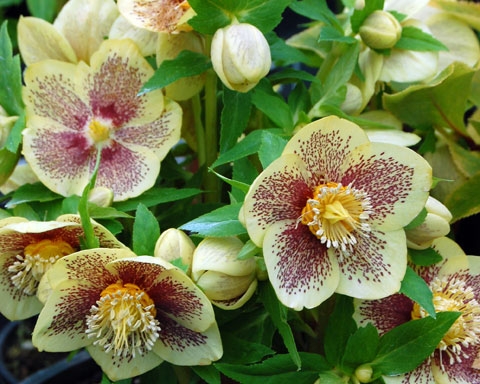
An added bonus is that hellebores are deer-resistant and do not freeze in cold winters.
Happy hellebores will self-sow if their flowers (which are actually sepals, rather than petals) are not cut off after the blooms have faded; seed pods will form, eventually (usually in July) dropping their seeds close by the mother plant, where new baby plants will develop. Because the new plants develop so close to the original plant, it is a good idea to thin the babies out or transplant them.
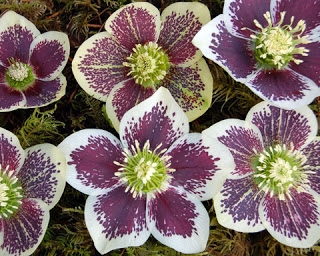
Right now, when you are raking up leaves and cleaning up your garden, is a good time to cut off last year's hellebore leaves (most hybrid hellebores are stemless). If there are no buds showing yet, you can simply grab the leaves by the handful and cut them off. If the plant has started to bud, just cut off last year's leaves. It is not absolutely necessary to do this, as new leaves will cover the old ones, and the old leaves will eventually turn brown and can be swept away by hand. If you are in doubt, it is safe to cut anything (stems or leaves) that has turned brown. Cutting them off does make yard raking easier, as once the leaves are gone you can rake right over the plant. This gives the garden a cleaner look now and also later, when the new leaves and buds appear and the plant blooms.
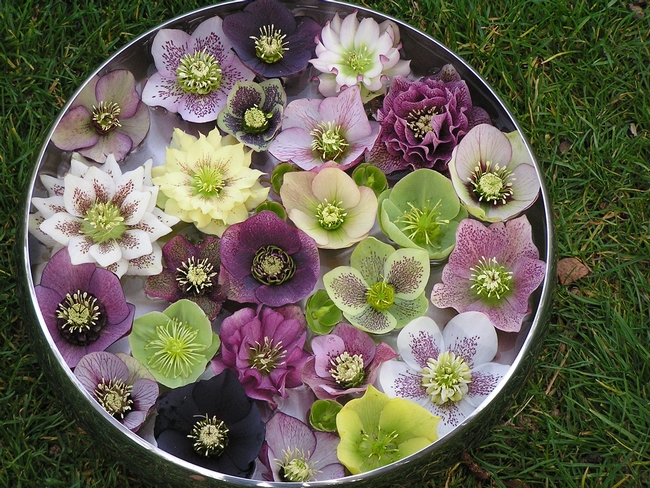
While some early-blooming hellebores are already in flower, most will bloom between late January and early April. Look for them at your favorite nursery.
UC Master Gardeners of Butte County are part of the University of California Cooperative Extension (UCCE) system. To learn more about us and our upcoming events, and for help with gardening in our area, visit our website. If you have a gardening question or problem, email the Hotline at mgbutte@ucanr.edu (preferred) or call (530) 538-7201.
By Jeff Oster, UC Butte County Master Gardener, September 29, 2017
It's not uncommon for a garden to seem a bit bare from late fall through early spring, when very little is in bloom. Luckily, hardy cyclamen and hellebores can help fill this gap by providing color from flowers while adding interest from leaf shapes and patterns as well.
Hardy Cyclamen
Cyclamen hederifolium and Cyclamen coum are smalller, garden-adapted relatives of the florist's cyclamen (C. persicum). They are both native to Mediterranean regions, and are the easiest species of cyclamen to grow in the home garden. Both species are hardy to USDA Zone 5 and do best in well-drained soil rich in humus, and located in areas of dappled (not heavy) shade among trees and shrubs. They are moderately drought-tolerant, very long-lived, and thrive with very little care.
To grow cyclamen, plant tubers in early fall, about one inch deep, and six inches apart. Low mounds are their ideal habitat. The tubers do not multiply, but plants will self-sow, forming colonies. In summer the plants go dormant and need a little moisture to keep roots from dying back. Watering in late summer and early fall breaks dormancy and encourages new growth.
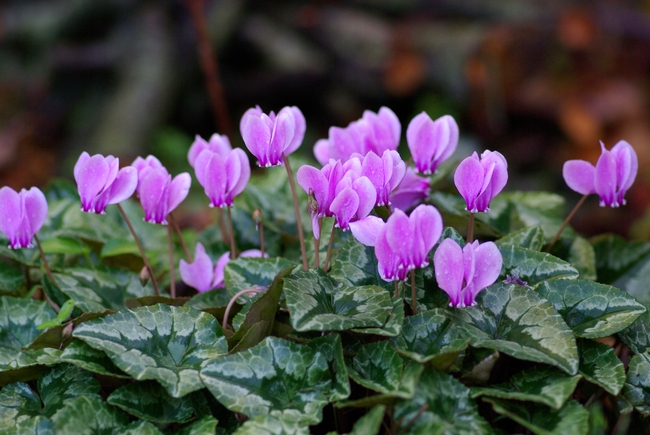
Foliage lasts until late spring and in a colony creates an almost evergreen ground cover. Leaf shapes vary from heart-shaped to spear-like. Leaves may be marbled green with a symmetrical darker green or silver fractal pattern. The tubers are long-lived, can grow to the size of a small dinner plate, and should produce a profusion of blooms.
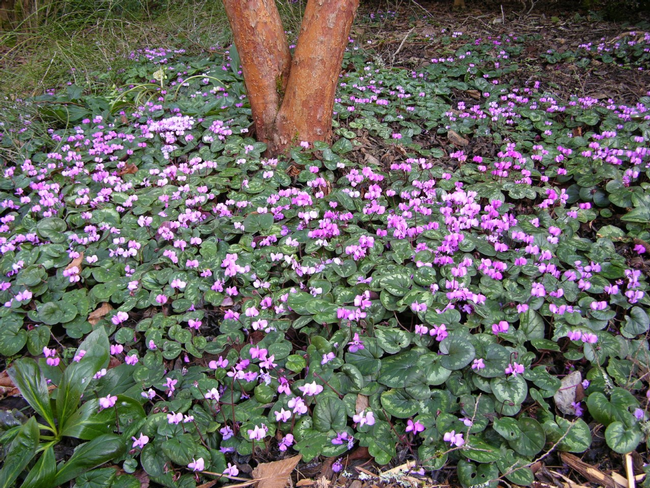
Watch for pests: root weevil, aphids, slugs, snails, mice and squirrels can do occasional damage to cyclamen.
Hellebores
The most common hellebores (Lenten roses) are the Oriental hybrids (Helleborus x hybridus). They are long-blooming (starting in February), low-maintenance, evergreen perennials which originated in Mediterranean regions. 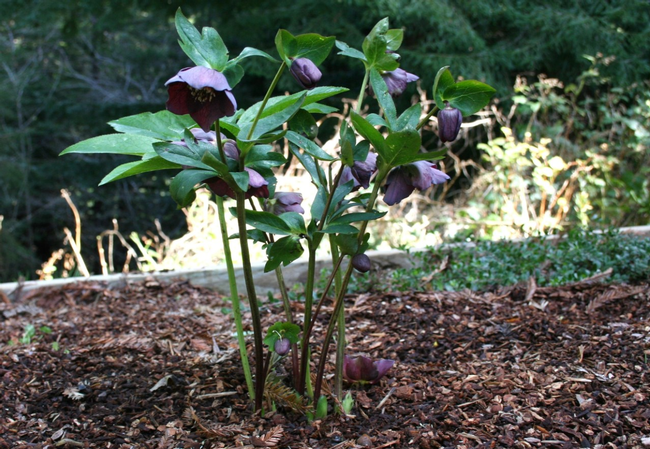
Helleborus niger is called the Christmas rose, and blooms earlier—late December or early January.
Hellebore colors range from white to purple, with many color patterns on the petals (which are actually bracts or calyxes). White flowers tend to turn green with age, while the purples hold their colors. Flowers may persist for 3 months.

Hellebores contain alkaloid toxins and have been used both as a poison and a purgative. They are pest-free and deer resistant.
For a long span of color from winter through spring, plant hellebores along with daffodils and hardy cyclamen.
For more information on cyclamen and hellebores, see:
Cyclamen Species for the Garden
Plant Hellebores for Winter and Spring Color
By David Walther, Butte County Master Gardener, December 27, 2013
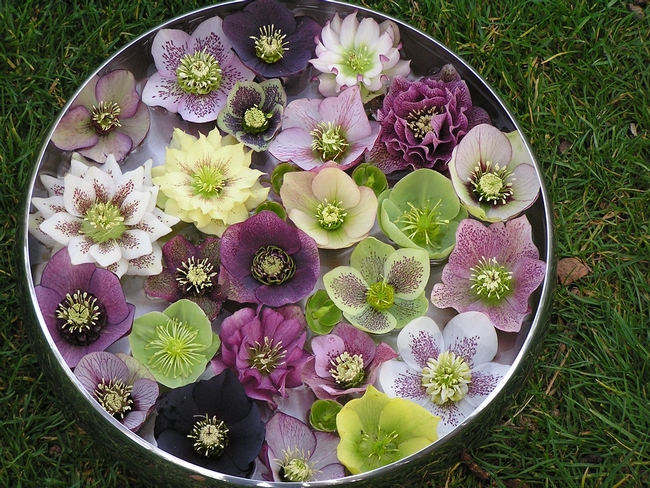
Hellebores like high shade and thrive under deciduous trees in well-drained fertile soil. Good locations include the north or east sides of walls, and underneath high-branching trees. Like many flowering plants that do well in shady conditions, hellebores do need light in order to bloom profusely, so the more sun you can provide them in a shady location, the more flowers you will have. While a daily blast of afternoon sun in late summer and fall may scorch their leaves, they will still bloom beautifully in the spring.
An added bonus is that hellebores are deer-resistant and do not freeze in cold winters.
Happy hellebores will self-sow if their flowers (which are actually sepals, rather than petals) are not cut off after the blooms have faded; seed pods will form, eventually (usually in July) dropping their seeds close by the mother plant, where new baby plants will develop. Because the new plants develop so close to the original plant, it is a good idea to thin the babies out or transplant them.
Fertilize in September, when they are forming the buds for their winter & spring flowers.
Right now, when you are raking up leaves and cleaning up your garden, is a good time to cut off last year’s hellebore leaves (most hybrid hellebores are stemless). If there are no buds showing yet, you can simply grab the leaves by the handful and cut them off. If the plant has started to bud, just cut off last year’s leaves. It is not absolutely necessary to do this, as new leaves will cover the old ones, and the old leaves will eventually turn brown and can be swept away by hand. If you are in doubt, it is safe to cut anything (stems or leaves) that has turned brown. Cutting them off does make yard raking easier, as once the leaves are gone you can rake right over the plant. This gives the garden a cleaner look now and also later, when the new leaves and buds appear and the plant blooms.
If you want a hellebore that blooms a particular color, it is best to buy the plant while it is in flower, so you know you are getting exactly what you want. That plant will always bloom that particular color, but there is no guarantee that its seedlings will follow suit.
While some early-blooming hellebores are already in flower, most will bloom between late January and early April. Look for them at your favorite nursery.


